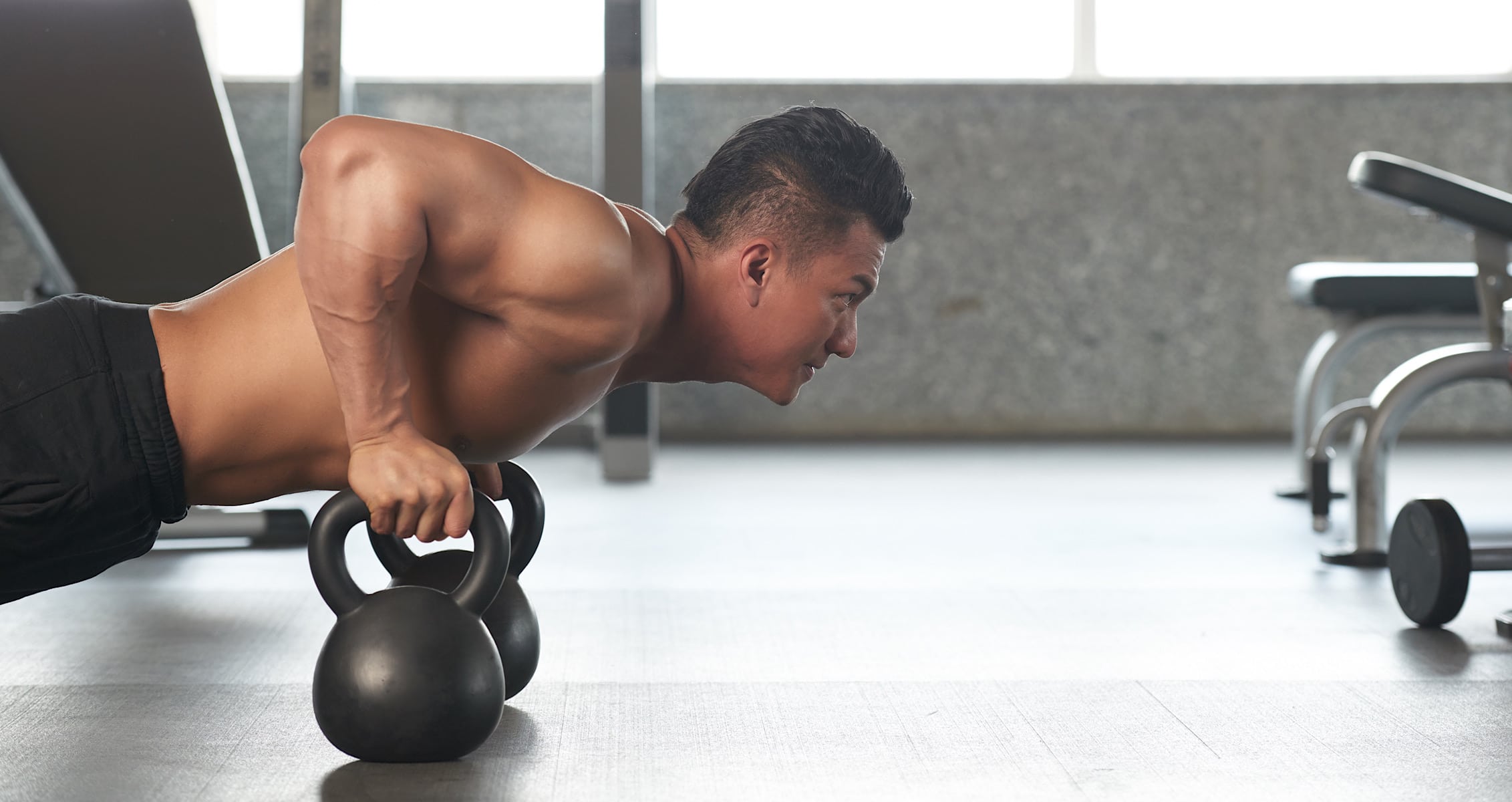10 Pec–Popping Push-Up Variations
Push-ups are underrated and underperformed. Although the benefits are clear, they’re often forgotten in the vast selection of programs out there. Walk into the gym any given Monday and you’ll see a lot of benching with little to no push-ups happening. That’s a problem.
Why you should be doing more push-ups:
• Increase Relative Strength. Your relative strength is your ability to move your body through space. Strive for a decent balance of both relative strength and free weight exercises in your program.
• Shoulder Health. Push-ups are a closed-chain exercise, where your hands are fixed in place and don’t move while pushing against an immovable object (in this case, the floor). This allows your scapulae (shoulder blades) to move freely as opposed to benching, where they’re fixed in place against the bench.
• Space/Equipment Efficiency. No gym? No problem. You can pump out push-ups pretty much anywhere you have floor space.
• Core Work. Contrary to popular belief, push-ups are more than just an upper body exercise. They require full body engagement while your core works hard to stabilize your torso throughout your set.
The last point is the focus of this article. Push-ups can become monotonous if you’re only doing one variation. You need variety in your exercises in order to elicit adaptation and continue to see gains. Plus, it keeps your workouts engaging and motivating.

10 Pec-Popping Push-Up Variations
1. Isometric Push-Up
Your muscles can contract concentrically (when it shortens under load), eccentrically (when it lengthens under load), and isometrically (when there is no change in joint angle under load).
Isometric push-ups are one of the most effective ways to increase total time under tension without any added resistance. What’s more, they’re a great way to practice optimal technique and reduce potential cheating.
Version 1: Perform a single rep for a 30-45 sec hold at the bottom (your chest should be an inch or two off the floor).
Version 2: Perform multiple reps with shorter holds(ex. 6-8 reps with 3-5 sec isometric at the bottom position).
2. Pec-Poppin Push-Up (DeFranco Variation)
This gem is one I borrowed from Joe DeFranco. If you have trouble feeling your pecs during push-ups, look no further. The previous variation showed an isometric contraction in the bottom portion of the push-up. Here, you’ll be adding an isometric contraction at the top.
How to do it:
• Start in a full push-up position and “pull” yourself down to the floor by pressing your hands down and back into the ground.
• Once you reach full depth, press back up until your arms are locked and hold.
• At the top, “drag” your hands together without actually moving them and hold for 2-3 seconds (squeeze your pecs as hard as you can while you hold).
10 reps is all you’ll need if you’re doing them right.
3. Eccentric Push-Up
It’s common to see lifters focus their effort on the concentric phase of exercises and completely neglect the eccentric. While a slow eccentric phase isn’t always warranted (ex. during a max effort deadlift), at times it can be a great way to increase your muscles’ total time under tension. I mean, if Arnold and Yates incorporated it into their training, there’s gotta be some benefit to it.
Since you’re stronger during the eccentric (lowering) phase of the push-up, you can handle more resistance and a slower tempo. And when it comes to building muscle, tempo is one of the most important training variables.
Tempo for exercises is like cooking times for recipes.If you take your chicken out of the oven 10 minutes early, it’s going to be inedible. Similarly, if your muscles aren’t under load for adequate time, adaptation and hypertrophy won’t occur.
Version 1: Perform a single rep for 20-40 sec. Add a weight vest or plate for extra resistance.
Version 2: Perform multiple reps with shorter eccentric phases (ex. 6-8 reps with 3-5 sec eccentric).
4. Full Stop Push-Up
Bring your chest to the floor and come to a full stop for a 1-2 sec. Keeping your body stiff as a board, push yourself back up as one tight unit (i.e. don’t let your chest rise up before your hips and vice versa).

The full stop push-up ensures you’re going to full depth and eliminates any potential cheating or momentum.
5. Decline Push-Ups
Decline push-ups are the bodyweight equivalent of inclined presses, with emphasis on the pec minor (upper portion of the chest). With most push-up and flat bench variations focusing on the pec major, this one is an essential part of your arsenal if you want to build a bigger, fuller chest.
6. Positional Isometric Push-Up
Positional isometrics are when you add segmented pauses throughout the entire range of motion an exercise. While isometrics don’t involve any movement, strength increases occur at roughly 10 degrees of either side of the joint angle. So if you’re feeling weakest at the bottom of the push-up, adding holds there will make you stronger in that position. Conversely, if you feel weakest at the top of your push-up, adding pauses there will make you stronger as you lockout.
How to do it:
• Start in a full push-up position and lower yourself ½ way and hold.
• Lower yourself to full depth with your chest an inch off the floor and hold again.
• Push yourself back up ½ way and hold one more time.
• Push yourself back up fully to your starting position and repeat.
Rep/set ranges are dependant on your goals and training history. In general, a 2-4 sec pause for 4-6 total reps is a good start.
7. Banded Push-Up
Banded push-ups are a great way to add accommodating resistance, whereby you’re increasing the resistance of the load throughout the range of motion. In other words, it gets harder as you reach the top of the push-up.
8. Med Ball Push-Up
The med ball push-up is like the bodyweight equivalent of a squeeze press (where you’re pushing the dumbbells into each other as you do a bench press). If you want to feel your chest light up during push-ups, look no further.
9. Pulsing Push-Up
Pulsing reps are basically 2 reps in 1. Go to the bottom of your push-up, come up ½ way, go back down to full depth, then push yourself up until your arms are locked. Adding the ½ rep places greater emphasis on your pecs as they’re working the hardest at the bottom of the push-up.
10. Kettlebell Push-Ups

Increasing the range of motion of your push-ups whereby you’re elevating your hands slightly is a sure-fire way to increase pec engagement. You can use kettlebells, plates, yoga blocks, or even a couple of thick books.
Summary
Push-ups (along with chin-ups) are the king of upper body relative strength exercises. Try each of these variations for 2-3 weeks at a time to battle the monotony of regular push-ups and continue to elicit adaptation for greater hypertrophy gains.
